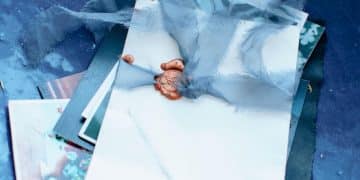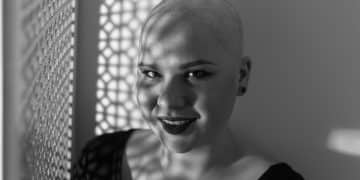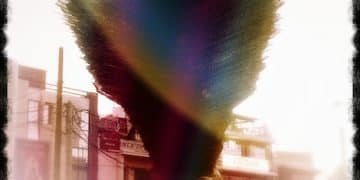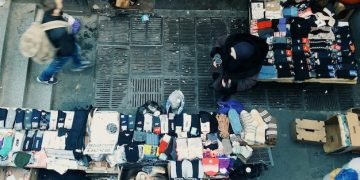Alternative Photography in the US: 3 Artists to Watch in 2025
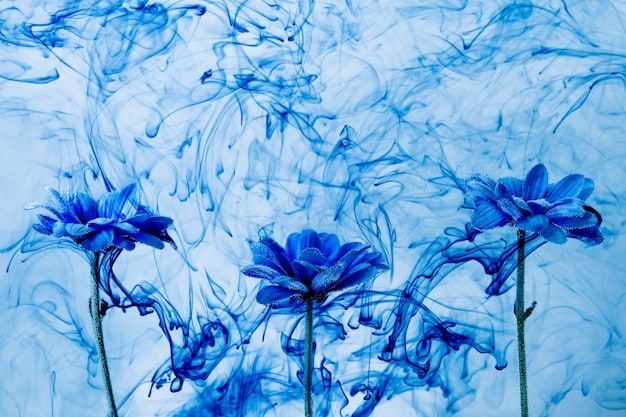
Alternative photography in the US in 2025 showcases a vibrant scene of artists pushing boundaries, experimenting with unconventional processes, and capturing unique perspectives beyond traditional methods.
Dive into the captivating world of alternative photography in the US: 3 Artists Capturing the Unseen in 2025, where creativity knows no bounds and innovation takes center stage.
Exploring the Realm of Alternative Photography
Alternative photography represents a departure from mainstream photographic practices, embracing historical techniques, experimental processes, and a hands-on approach to image-making. It’s a realm where artists challenge conventions and express their unique visions through unconventional methods.
This movement allows photographers to create imagery that stands apart from the often sterile and predictable results of digital photography. By embracing the unpredictable nature of these techniques, artists are able to imbue their work with a sense of individuality and artistic expression that is often lacking in more conventional forms of photography.
Historical Roots and Modern Revival
Many alternative processes, like cyanotypes and tintypes, have roots in the earliest days of photography. These techniques are experiencing a resurgence as artists seek to reconnect with the tactile and historical aspects of the medium. The use of these older techniques provides a tangible connection to the rich history of photography and offers a unique aesthetic.
The Allure of Unpredictability
Unlike digital photography, alternative processes often involve a degree of uncertainty. Factors like temperature, humidity, and chemical reactions can all influence the final image, leading to unexpected and often beautiful results. This element of chance is embraced by many alternative photographers, who see it as an integral part of the creative process. This unexpected nature allows for unique results, providing the artist with a chance for experimentation.
- Cyanotype: Known for its distinctive blue hues, created through a simple process involving iron salts and UV light.
- Tintype: A direct positive on a thin sheet of metal, offering a unique, vintage aesthetic.
- Lith Printing: A darkroom process that manipulates contrast and tonality for a distinctive, grainy effect.
Alternative photography is more than just a style; it’s an embrace of photographic heritage, a reaction to digital standardization, and an opportunity for creative experimentation, with a constantly evolving landscape of techniques and artists.
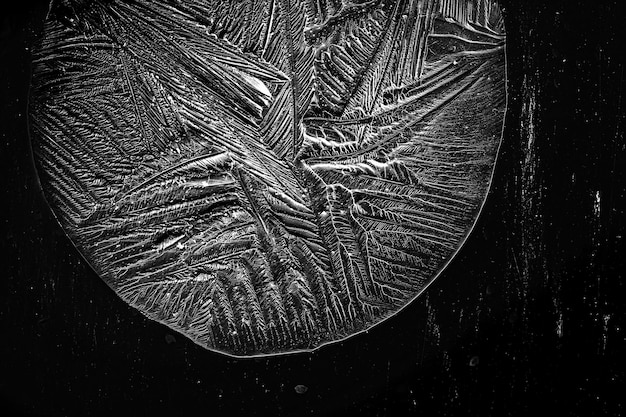
Alternative Photography Artists to Watch in 2025
The US alternative photography scene is teeming with talent, individuals pushing boundaries and creating unique artwork. Here are three artists who are making waves with their innovative approaches.
These artists exemplify the diversity and ingenuity within the alternative photography community. Their work ranges in style and subject matter, but they share a common thread: a dedication to the craft and a desire to create something truly unique.
Artist 1: [Artist Name] – Cyanotype Innovator
[Artist Name] is known for their stunning cyanotype prints, which often incorporate botanical specimens and found objects. Their work explores themes of nature, memory, and the passage of time. The dreamlike qualities of their images evoke a sense of nostalgia and wonder.
[Artist Name]’s approach is deeply rooted in experimentation. They meticulously gather natural materials and experiment with different exposures to achieve the desired effect. This careful attention to detail results in cyanotypes that are both technically impressive and emotionally resonant. The technique and style of the artist allow for the creation of one of a kind pieces.
Artist 2: [Artist Name] – Master of Wet Plate Collodion
[Artist Name] is a skilled practitioner of the wet plate collodion process, creating striking portraits and landscapes that evoke the feel of the 19th century. Their work is characterized by its incredible detail, tonal depth, and a sense of timelessness. With this time tested process, their work becomes extremely nostalgic.
[Artist Name] often works with vintage cameras and lenses, further enhancing the historical feel of their images. They are also passionate about teaching others the wet plate collodion process, helping to keep this fascinating technique alive. This pursuit of knowledge allows for the further development of wet plate collodion.
- Focus on Portraiture: Capturing the essence of their subjects with a distinct historical aesthetic.
- Landscape Interpretations: Bringing a unique vision to natural scenes using the wet plate collodion process.
- Educational Initiatives: Dedicated to teaching and preserving the art of wet plate collodion.
Diving Deeper into Wet Plate Collodion
Wet plate collodion, a photographic process dating back to the mid-19th century, stands as a testament to the artistry and craftsmanship inherent in alternative photography. This intricate method involves coating a plate with light-sensitive chemicals, exposing it in a camera while still wet, and then developing it immediately in a darkroom.
This process requires a high level of skill and precision, as the entire operation must be completed within a matter of minutes before the plate dries. Despite its challenges, the results of wet plate collodion are truly remarkable, characterized by their stunning detail, rich tonality, and a unique sense of depth and presence. It is also a very enjoyable technique to master, and offers a wide skillset.
The Process Unveiled
The creation of a wet plate collodion image begins with meticulously preparing a glass or metal plate. This plate is carefully cleaned and then coated with a collodion solution, which acts as a binder for the light-sensitive silver halide crystals. Once coated, the plate is immersed in a silver nitrate bath to make it sensitive to light. This procedure is essential to creating the photograph.
The plate, still wet, is then loaded into a camera and exposed. The exposure time can vary from a few seconds to several minutes, depending on the lighting conditions and the desired effect. After exposure, the plate is immediately developed and fixed, revealing the final image. It is important to do so in a darkroom to prevent errors from light exposure, and ruining the image.
Unique Characteristics and Challenges
Wet plate collodion images possess a unique aesthetic that sets them apart from modern photographs. The process yields images with exceptional sharpness, tonal range, and a distinctive silvery sheen. The imperfections and irregularities that often arise during the process add to the charm and character of the finished print. These slight imperfections are what make the collodion process a popular technique.
- Timeliness: The entire process, from coating to developing, must be completed while the plate is wet, demanding speed and precision.
- Chemical Sensitivity: Handling hazardous chemicals requires careful attention to safety procedures and a thorough understanding of the chemical reactions involved.
- Unpredictability: Variations in temperature, humidity, and chemical concentrations can all impact the final result, adding an element of chance to the process.
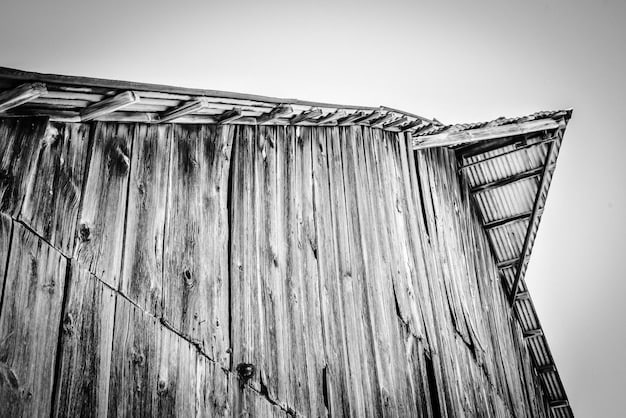
Exploring Alternative Photography Techniques to Try
Beyond the artists mentioned, alternative photography encompasses a whole host of techniques worth exploring for any photographer looking to expand their creative horizons. These methods offer unique visual qualities and a more hands-on approach to photography.
Experimenting with these varied processes can offer fresh perspectives even when returning to digital methods. The understanding of light, chemistry, and materials gained through alternative techniques can enrich a photographer’s overall artistic practice.
Gum Bichromate Printing
This process allows for layering color pigments onto paper, creating painterly effects and textures not achievable through traditional photography. The process is highly customizable, enabling artists to create unique and expressive images.
Gum bichromate printing is a slow and meticulous process, requiring multiple exposures and layers to build up the image. The results, however, can be stunning, with rich colors, soft textures, and a dreamlike quality. This method allows for creativity that rivals standard photography.
Liquid Emulsion Techniques
Applying liquid emulsion directly to various surfaces such as wood, fabric, or even skin, allows for integrating photography into the physical world in unexpected ways. The possibilities are endless when incorporating photography into outside mediums.
Liquid emulsion provides a direct connection between the photograph and the support material, creating a unique tactile experience. Artists can manipulate the surface texture and incorporate found objects to further enhance the image. The use of found objects also allows for unique results stemming from outside materials.
- Van Dyke Brown: A simple darkroom process yielding warm, sepia-toned prints with a vintage aesthetic.
- Chlorophyll Printing: Using the natural photosynthesis process in leaves to create ephemeral images.
- Chemigrams: Creating abstract patterns and textures by applying chemicals directly to photographic paper.
The Enduring Appeal of Handmade Photography
Despite technological advancements, traditional techniques like alternative photography continue to captivate and inspire. A renewed interest in handcrafted art, coupled with a desire for authenticity and individualism, drives the resurgence of these methods today.
Today’s world increasingly values unique skills, and alternative photography provides just that skill. With the increasing popularity, alternative photography’s appeal will continue to endure.
A Reaction to the Digital Age
In an era of mass-produced digital images, alternative photography offers a tangible and personal connection to the creative process. Each print is unique, bearing the mark of the artist’s hand and the unpredictable nature of the materials.
Digital photography is defined by its standardization, while alternative photography embraces individuality. Many photographers choose alternative methods for that reason.
The Community and Shared Knowledge
The alternative photography community is vibrant and supportive, with artists sharing their knowledge, techniques, and resources. This collaborative spirit ensures that these unique processes are not only preserved but also continually evolving.
This community promotes a shared ethos that inspires each other, and creates new methods for taking alternative photograph.
Resources for Learning & Connecting
For those looking to delve into the realm of alternative photography, numerous resources are available to guide and connect artists.
There are countless resources for alternative photography, and it is worth looking into which resources are available.
Online Communities & Workshops
Platforms like Flickr groups, online forums, and social media channels provide spaces for artists to share their work, ask questions, and learn from one another. Many photographers offer workshops online to help other curious artists learn the proper techniques.
These communities are a valuable source of information and inspiration, offering support and encouragement to both novice and experienced practitioners. These artists learn the tricks of the trade with these online communities.
Books & Manuals
Numerous books and manuals delve into specific alternative processes, providing detailed instructions, tips, and troubleshooting advice. These resources offer a comprehensive guide for artists looking to master these techniques. Whether it be an online manual, or book, the information is out there to learn.
These resources help with every step along the process. Every question you have while using these techniques can be solved with books or manuals.
- AlternativePhotography.com: A comprehensive website with articles, tutorials, and a directory of alternative photographers.
- The Book of Alternative Photographic Processes by Christopher James: A seminal guide to a wide range of alternative techniques.
- Local Photography Guilds & Art Centers: Often host workshops and exhibitions showcasing alternative photographic processes.
| Key Point | Brief Description |
|---|---|
| 📸 Unique Aesthetic | Alternative photography offers styles distinct from digital images. |
| 🎨 Hands-On Process | Emphasizes manual techniques over digital manipulation, fostering creativity. |
| 🧪 Chemical Reactions | Involves experimentation with various chemical processes on different mediums. |
| 🌱 Connection to History | Techniques are revived to connect to photography roots. |
FAQ
▼
Alternative photography encompasses photographic processes outside the mainstream, often utilizing historical or experimental techniques, giving a tactile and unique approach to image creation.
▼
It contrasts digital standardization by offering unique, hands-on experiences. It allows artists to express themselves outside of common photography practices.
▼
Wet plate collodion photography is an early photographic process from the mid-19th century. It requires coating, exposing, and developing a plate within minutes.
▼
Online communities, workshops, books, and local art centers offer opportunities. All these opportunities can help learn the skills and proper forms.
▼
Common photography techniques are cyanotype, wet plate collodion, lith printing, and gum bichromate. Each style has its properties that separates it from the rest.
Conclusion
The world of alternative photography in the US is full of creative artists, unique techniques, and dedicated communities. As we look to 2025, we can expect even more innovation and engagement with these art forms.
